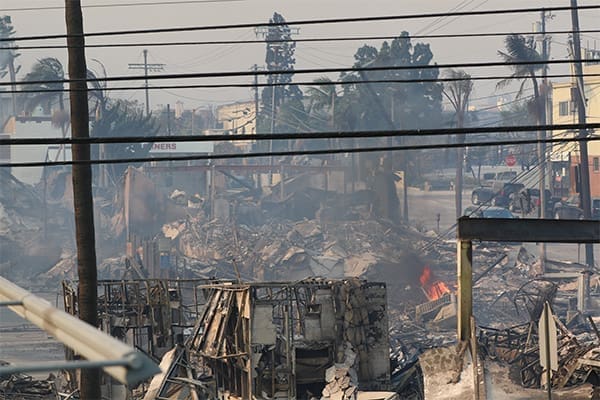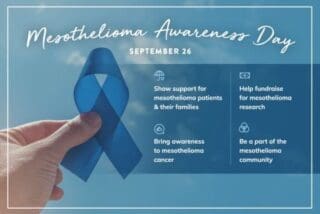
On January 7, 2025, two wildfires erupted in the Los Angeles (LA) area. The first began in the Pacific Palisades neighborhood and the second in the forests north of Pasadena (Eaton Fire). A handful of smaller fires soon followed. It took firefighters 24 days to fully contain them.
By the time they were under control, the fires had burned over 37,000 acres and claimed at least 30 lives. The California Department of Forestry and Fire Protection reported over 16,000 structures destroyed.
But the dangers of the wildfires extend well beyond their extinguishment. As we’ve written about before, wildfires pose serious asbestos safety threats. Inhaling asbestos released from damaged buildings can cause mesothelioma and other cancers.
The Palisades and Eaton fires created a lot of asbestos waste. More than 40% of properties in the Palisades Fire and 60% in the Eaton Fire tested positive for asbestos. The Los Angeles County Department of Public Health warned residents about hazardous substances within 250 yards of any burned structure.
What Are Officials Doing About Asbestos Waste in the LA Area?
On January 15, the Los Angeles County Department of Public Health issued a Local Health Emergency Order. The order mandated government hazardous materials inspections before removing fire debris. LA County divided the cleanup into two phases. Both phases are at no cost to residents.
Cleanup Phase 1
Phase 1 of the cleanup was hazardous waste removal, including asbestos removal. The U.S. Environmental Protection Agency (EPA) was given a 30-day deadline from the Trump administration to complete Phase 1. For context, the deadly 2023 fire in Maui destroyed over 2,000 buildings. The EPA needed over 4 months to complete hazardous waste removal then.
Structural issues barred the EPA from touching about a third of the burned buildings. Instead, the organization deferred them to Phase 2. It marked Phase 1 as complete after only 28 days.
Cleanup Phase 2
Phase 2 is fire debris removal, which the U.S. Army Corps of Engineers (USACE) oversees. It involves sealing and removing ash and other debris. This phase also finishes hazardous waste removal and asbestos cleanup from Phase 1.
Normally, this type of toxic debris goes to hazardous waste facilities. But with emergency waivers, regular landfills are accepting potentially toxic ash and debris. The Calabasas, Sunshine Canyon and Lancaster landfills have all received untested fire debris.
Those who live near the landfills have protested the decision. They argued that the debris risks polluting the air or groundwater. Some protesters even blocked trucks laden with debris from entering the landfills. Battles continue between government officials and local communities over where to dump fire debris.
At the moment, the USACE has removed more than a million tons of fire debris from the affected areas. They expect to complete Phase 2 in January 2026, with the majority of the work done by the end of June 2025.
Heading Home
Even beyond both phases of the cleanup, problems may persist. Concerns over lingering toxins in the soil have already stopped many residents from heading home. Normally, the Federal Emergency Management Agency (FEMA) performs soil testing after a cleanup.
But this time, FEMA is breaking tradition and refusing to test soil. The agency claims that having the USACE remove the top 6 inches of topsoil during Phase 2 is sufficient, despite research to the contrary. One homeowner had to pay $2,500 for tests, which came back positive for many toxins. That price tag doesn’t include treatment and removal of the toxins.
Many have criticized the government for not assisting families that can’t afford to test and clean. LA County initially stated it wasn’t responsible for testing for and cleaning toxins on private properties. LA officials have also said they will not require soil testing for people to rebuild their homes.
Finding Help After the Fires
Hundreds of homeowners have filed permits and plans to rebuild. Some rebuilding projects are already underway. LA County has now allocated $3 million to help homeowners in the Eaton burn area pay for soil testing.
In the absence of federal assistance, several universities have come forward to help. For instance, researchers from Loyola Marymount University, UCLA and Purdue University have banded together to form the Community Action Project LA. The project is providing free soil testing for homeowners.
For the most expensive natural disaster in U.S. history, the road to recovery will be long. Some homeowners may need to do additional asbestos abatement before rebuilding.
In the meantime, learn how to protect yourself from asbestos before, during and after a wildfire.




